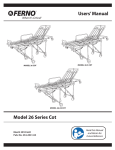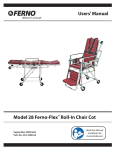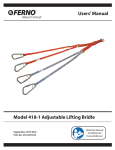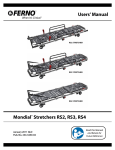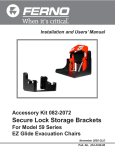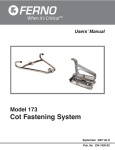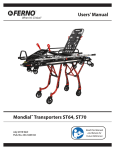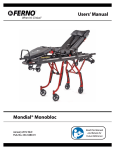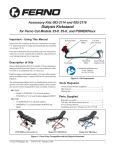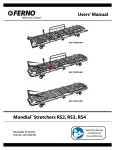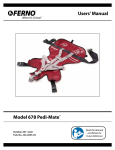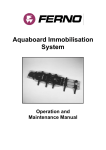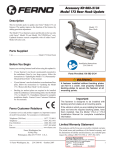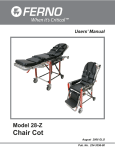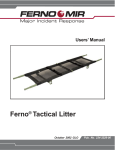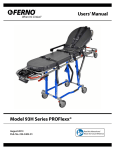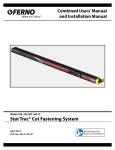Download USINg THE CoT
Transcript
FERNO When It’s Critical ® User’s Manual Model 5126-EL and 5226-EL Easy Loading Multi-Level Cots August 2008 INT Pub. No. 234-3415-00 Read this Manual and Retain for Future Reference Model 5026-EL Series Cot Disclaimer Proprietary Notice This manual contains general instructions for the use, operation and care of this product. The instructions are not all-inclusive. Safe and proper use of this product is solely at the discretion of the user. Safety information is included as a service to the user. All other safety measures taken by the user should be within and under consideration of applicable regulations. It is recommended that training on the proper use of this product be provided before using this product in an actual situation. The information disclosed in this manual is the property of Ferno-Washington, Inc., Wilmington, Ohio, USA. FernoWashington, Inc. reserves all patent rights, proprietary design rights, manufacturing rights, reproduction use rights, and sales use rights thereto, and to any article disclosed therein except to the extent those rights are expressly granted to others or where no applicable to vendor proprietary parts. Retain this manual for future reference. Include it with the product in the event of transfer to new users. Additional free copies are available upon request from Customer Relations. The products sold by Ferno are covered by a limited warranty, which is printed on the invoice you received when you purchased the product. Please refer to the warranty terms as printed on your invoice. The complete terms and conditions of the limited warranty, and the limitations of liability and disclaimers, are also available upon request by calling Ferno at 1.800.733.3766 or 1.937.382.1451. Limited Warranty Statement Ferno Customer Relations Customer service are product support are important aspects of each Ferno product. For assistance or information, contact your Ferno distributor or Ferno Customer Relations. Please have the serial number available when calling Ferno Customer Relations, and include it in all written communications. Ferno-Washington, Inc. 70 Weil Way Wilmington, Ohio 45177-9371, U.S.A. Telephone (U.S.A. and Canada)...................1.877.733.0911 Telephone (Worldwide).............................. +1.937.382.1451 Fax (U.S.A. and Canada)..............................1.888.388.1349 Fax (Worldwide)........................................ +1.937.382.6569 Internet......................................................... www.ferno.com European Representative Ferno (UK) Limited Stubs Beck Lane, Cleckheaton West Yorkshire BD19-4TZ, United Kingdom Telephone........................ +44 (1274) 851999 Fax...................................+44 (1274) 851111 Internet................................www.ferno.co.uk Serial Number _________________________ Location: Crosstube Under Shock Frame. Users’ manual To request additional free users’ manuals, contact Ferno Customer Relations, your Ferno distributor, or visit www.ferno.com. © Copyright Ferno-Washington, Inc. All Rights Reserved. 2 © Ferno-Washington, Inc 234-3415-00 August 2008 Model 5026-EL Series Cot Table of Contents Section Page 1 - Safety Information........................................................4 1.1 Warning..................................................................4 1.2 Important................................................................4 1.3 Bloodborne Disease Notice....................................4 1.4 Cot and Fastener Compatibility.............................4 1.5. Compliance with Current Safety Regulations........4 1.6 Safety labels...........................................................5 1.7 Symbol Glossary....................................................5 2 - Operator Skills and Training.......................................6 2.1 Skills......................................................................6 2.2 Training..................................................................6 2.3 Height and Strength Considerations......................6 3 - About the Cot................................................................7 3.1 Description.............................................................7 3.2 Components...........................................................7 3.3 General Specifications...........................................8 3.4 Cot Positions..........................................................8 4 - Setup/Installation..........................................................9 4.1 Loading Surface Specifications ............................9 4.2 Restraints, Mattress and Accessories...................10 5 - Using the Features...................................................... 11 5.1 Easy Loading System...........................................11 5.3 Leg Control Handles............................................13 5.4 Sidearms...............................................................14 5.5 Shock Frame........................................................14 5.6 Backrest................................................................15 5.7 Wheel Locks........................................................15 © Ferno-Washington, Inc 234-3415-00 August 2008 Section Page 6 - Using the Cot...............................................................16 6.1 Before Placing the Cot in Service........................16 6.2 General Guidelines for Use..................................16 6.3 Changing Cot Positions.......................................17 6.4 Transferring the Patient to the Cot.......................18 6.5 Rolling the Cot.....................................................19 6.6 Loading the Cot....................................................20 6.7 Unloading the Cot................................................21 6.8 Using Additional Help.........................................22 8 - Maintenance................................................................23 8.1 Maintenance Schedule.........................................23 8.2 Disinfecting and Cleaning the Restraints.............23 8.3 Disinfecting the Cot.............................................23 8.4 Cleaning the Cot..................................................23 8.5 Waxing the Cot....................................................23 8.6 Inspecting the Cot................................................24 8.7 Lubricating the Cot..............................................25 9 - Parts and Service........................................................26 9.1 Worldwide............................................................26 10 - Accessories . ..............................................................26 Training Record...............................................................27 Maintenance Record........................................................27 3 Safety Information Model 5026-EL Series Cot 1 - Safety Information 1.1 Warning 1.3Bloodborne Disease Notice Warning notices indicate a potentially hazardous situation which, if not avoided, could result in injury or death. To reduce the risk of exposure to bloodborne diseases such as HIV-1 and hepatitis when using the cot, follow the disinfecting and cleaning instructions in this manual. Warning Untrained operators can cause injury or be injured. Permit only trained personnel to operate the cot. Improper use of the cot can cause injury. Use the cot only for the purpose described in this manual. Attaching improper items to the cot can cause injury. Use only Ferno-approved items on the cot. Improper operation can cause injury. Operate the cot only as described in this manual. An unattended patient can be injured. Stay with the patient at all times. An unrestrained patient can fall off the cot and be injured. Use restraints to secure the patient on the cot. Helpers can cause injury or be injured. Maintain control of the cot, operate the CONTROLS, and direct all helpers. Improper maintenance can cause injury. Maintain the cot only as described in this manual. Improper parts and service can cause injury. Use only Ferno parts and Ferno-approved service on the cot. Modifying the cot can cause injury and damage. Use the cot only as designed by Ferno. 1.2 Important Important notices emphasize important usage or maintenance information. Important 1.4 Cot and Fastener Compatibility For the purpose of this notice, this cot and all Ferno transporters are included under the generic term, “cot.” Combining different manufacturers’ products into a “mixedcomponent” cot/cot fastener system can increase the user’s risk of injury and damage. Ferno-Washington, Inc. strongly recommends that only Ferno-manufactured cots be used in Ferno-manufactured cot fasteners, and that only Ferno-manufactured cot fasteners be used for securing Ferno-manufactured cots in ambulances. ANY COMBINATION OF A FERNO COT OR COT FASTENER WITH A NON-FERNO COT OR COT FASTENER IS MISUSE OF THE FERNO PRODUCT. Responsibility for the outcome of know, intentional misuse rests squarely on the misuser. 1.5.Compliance with Current Safety Regulations The multi-level self-loading cots Model 5126-EL and 5226-EL are designed and built by Ferno Washington Inc. in compliance with the safety requirements called for by directive 93/42/EEC dated 06/14/93 (class I) concerning medical devices. All the materials used are designed to work properly within the load limits indicated in the technical specifications and are flame resistant, do not release any toxic or polluting substances, and are protected to provide a high level of resistance to wear and tear and corrosion. In making the self-loading cot, corners and sharp edges that could cause accidental harm to the personnel using the cot were avoided. 4 © Ferno-Washington, Inc 234-3415-00 August 2008 Model 5026-EL Series Cot Safety Information 1.6 Safety Labels Safety labels link important information between the manual and the cot. Read and follow the instructions, and immediately replace any worn or damaged labels. For replacement labels, see Parts and Service, page 26. The labels below are placed on the cot. 1.7 Symbol Glossary The symbols defined below are used on the cot and in this users’ manual. Ferno uses symbols recognized by the International Standards Organization (ISO), American National Standards Institute (ANSI) and the emergency medical services industry. 2 181 kg 400 lb General Warning of Potential Injury Keep Clear of This Area Pinch Point Load Limit Pinch Point © Ferno-Washington, Inc 234-3415-00 August 2008 Read the Users’ Manual Do Not Lubricate Cot Operation Requires Two Trained Operators Lubricate Product meets European Union Standards 5 Operator Skills and Training Model 5026-EL Series Cot 2 - Operator Skills and Training 2.1 Skills 2.2 Training Operators using the cot need: Trainees need to: ● a working knowledge of emergency patient-handling procedures. ● the ability to assist the patient. ● read and understand this manual. ● be trained and tested on the use of the cot. ● practice with the cot before using it with a patient. ● record their training information. A sample training record sheet is provided on page 27. Warning Untrained operators can cause injury or be injured. Permit only trained personnel to operate the cot. 2.3 Height and Strength Considerations When unloading the cot, the foot-end operator must lift and hold the weight of the cot, patient and equipment high enough for the wheels to remain off the ground until the undercarriage legs completely unfold and lock into place. Be aware that if the ambulance is parked on an uneven surface, the foot-end operator (and any helpers) may need to lift the cot higher than usual to allow the legs to unfold completely and lock. Supporting this weight requires greater strength from short operators than from tall operators because short operators must raise their arms higher in relation to their shoulders. Note: Use additional help as needed to lift the weight of the cot, patient and equipment (see Using Additional Help, page22). 6 © Ferno-Washington, Inc 234-3415-00 August 2008 Model 5026-EL Series Cot About the Cot 3 - About the Cot 3.1 Description The Model 5026-EL Series includes the Model 5126-EL cot and the Model 5226-EL cot. Both are referred to as “the cot” in this manual. Warning Improper use of the cot can cause injury. Use the cot only for the purpose described in this manual. The cot is an emergency patient-handling device. It is for professional use by a minimum of two trained operators. A set of patient restraints and a mattress are also required and are purchased separately. The 5126-EL and 5226-EL cots are identical except that the 5226-EL is higher than the 5126-EL. Illustrations throughout the manual represent both cot models and text differs only where cot dimensions are specified. Compatible fastener The cot is designed for use with a Ferno SLAM 5026EFX cot fastener (not included). AMBULANCE REQUIREMENTS The compartment in the ambulance must have sufficient space to accommodate the folded cot and must have the cot fastener installed. The loading surface must have minimum internal dimensions of 190 x 58 cm and a height from the ground of between 64 and 66 cm for the Model 5126-EL and between 70 and 72 cm for the Model 5226-EL. Cot features ● Easy Loading System ● 7 height positions ● Adjustable backrest ● Swing-down sidearms ● Pull handle ● Two swivel wheels with locks (operator end of cot). Wheels swivel with cot in positions 4, 5, and 6. ● Shock frame ● Automatic release of front legs when loading into an ambulance. ● Safety stop ● Rigid panels 3.2 Components Shock Frame Head End Adjustable Backrest Front Leg Control Handle Pull Handle Loading Wheels Rear Leg Control Handle Front Leg Release Assembly Swivel Wheels With Wheel Locks (2) Foot End © Ferno-Washington, Inc 234-3415-00 August 2008 Rear Legs Front Legs 7 About the Cot Model 5026-EL Series Cot 3.3General Specifications 3.4 Cot Positions Reference Height1 5126-EL 5226-EL Bed Position 7 (loaded) Bed position 6 Loading Height Bed Position 5 Bed Position 4 Bed Position 3 Bed Position 2 Bed Position 1 (folded) Length Width Weight2 Load Limit 28 cm 89 cm 64 cm 85 cm 80 cm 68 cm 50 cm 25 cm 197 cm 55 cm 43 kg 181 kg 28 cm 96 cm 71 cm 90 cm 83 cm 71 cm 53 cm 27 cm 197 cm 55 cm 44 kg 181 kg Position 7 - Loaded Position 6 - Transport and Loading Metric specifications are rounded to the nearest whole number. For more information, contact Ferno Customer Relations. Bed Position height is measured from the ground to the top of the upper frame (tube diameter 28 mm) the surface on which the patient rests. Loading height is measured from the ground to the bottom of the loading wheels. 1 2 Position 5 - Transport Weight is without mattress, restraints and optional features. Ferno reserves the right to change specifications without notice. Position 4 - Transport and Patient Transfer 181 kg 400 lb LOAD LIMIT Inspect the cot if the load limit of 181 kg has been exceeded (see section “Cot Inspection”). Position 3 - Patient Transfer Position 2 - Patient Transfer Position 1 - Patient Transfer 8 © Ferno-Washington, Inc 234-3415-00 August 2008 Model 5026-EL Series Cot Setup/Installation 4 - Setup/Installation 4.1 Loading Surface Specifications For optimum operation of the cot during the loading and unloading phases, the following dimensions for the loading surface and the corresponding position of the SLAM 5026EFX cot fastener are suggested (Figure 1). Important Loose items and debris on the patient compartment floor can interfere with the operation of the cot with the fastener. Keep the patient compartment floor clear. SLAM Box Figure 1 - Suggested Mounting Dimensions (Dimensions Shown in Millimeters) Safety lock device When the cot is unloaded from the ambulance properly, the front legs unfold completely (Figure 2). If the cot is improperly unloaded from the ambulance and the front legs do not unfold completely, the safety lock device stop bar on the cot will contact the SLAM box (Figure 3) to stop the cot’s movement and prevent it from being pulled from the ambulance before the front legs have completely unfolded. (Figure 3). For proper operation of the Safety Lock Device: Position the SLAM box at the point where, when the front legs of the cot unfold completely during unloading, the safety lock device stop bar is raised before it reaches the SLAM box. Figure 2 - Unloading the Cot © Ferno-Washington, Inc 234-3415-00 August 2008 Figure 3 - Stop Bar Catching Fastener 9 Setup/Installation 4.2 Restraints, Mattress and Accessories Before placing the cot in service, assign appropriate personnel to install the restraints and mattress (purchased separately from the cot) and any accessories shipped with the cot. Restraints are required for patient safety. Ferno recommends using the Model 417-1 torso restraint (a four-point harness) plus two Model 430 two-piece restraints for the hips and legs (see Accessories, page 26 for ordering information). See Figure 4. Install restraints and accessories according to the users’ manuals supplied with them. Keep restraint and accessory manuals with this manual for future reference. For additional, free manuals, contact Ferno Customer Relations (page 2). Model 5026-EL Series Cot Warning Attaching improper items to the cot can cause injury. Use only Ferno-approved items on the cot. Model 417-1 Torso Restraint Model 430 Two-Piece Restraints Figure 4 - Ferno Restraints Recommended for Use with Model 5126-EL and 5226-EL Cots 10 © Ferno-Washington, Inc 234-3415-00 August 2008 Model 5026-EL Series Cot Using the Features 5 - Using The Features 5.1 Easy Loading System The EL (Easy Loading) system consists of an automatic release mechanism for the front legs of the cot (Figure 5) plus total and independent closing of the front legs during the first part of loading (see Figure 6). The automatic release mechanism is made of a system of levers and is actuated by contact between the runner and the ambulance floor. This system allows the cot to be loaded into an ambulance without the operator needing to activate the release handle until the rear legs contact the ambulance. Runner Figure 5 - Easy-Loading Mechanism Figure 6- Loading the Cot © Ferno-Washington, Inc 234-3415-00 August 2008 11 Using the Features Model 5026-EL Series Cot 5.2 Safety Mechanisms Safety lock device The safety lock device prevents the cot from being unloaded from the vehicle before the front legs have completely unfolded to the normal transport position. During normal unloading, when the legs lock into place, the stop bar allows the cot to be removed from the ambulance (Figure 7). If the front legs have not unfolded completely, the safety lock stop bar will contact the SLAM box to stop the cot from being pulled any further out of the ambulance (Figure 8). If this should occur, the operators must follow the recovery procedure below: 1. Control Operator: Lift the foot end of the cot high enough to allow both sets of legs to unfold completely and lock in position. Figure 7 - Stop Bar Lifted During Proper Unloading 2. Both Operators: Confirm that both legs are locked in the normal transport position, then resume unloading the cot. For complete unloading instructions, see Unloading the Cot, page 21. Ratchet- bar safety catch The ratchet-bar safety catch offers two additional lock points for the head-end legs at intermediate levels. If the cot is removed from the patient compartment without the front legs completely unfolded, a plunger in the undercarriage assembly catches the ratchet bar notches to hold the cot at an intermediate level, preventing it from lowering to the ground. Figure 8 - Stop Bar Lowered During Improper Unloading If the ratchet-bar safety catch system is activated, operators must follow the recovery procedure below: 1. Assisting Operator: Immediately move to the head end of the cot and lift the head end high enough to allow the front legs to unfold completely and lock into place (Figure 9). 2. Both Operators: Stand at opposite ends of the cot, grasp the main frame, and lift the cot off its transport wheels to confirm that the legs have locked into position. When you are certain both sets of legs are locked, set the cot on the ground. For complete unloading instructions, see Unloading the Cot, page 21. 3. Both Operators: Roll the cot away from the ambulance. Figure 9 - Cot Stopped at an Intermediate Level by the Ratchet-Bar Safety Catch System 12 © Ferno-Washington, Inc 234-3415-00 August 2008 Model 5026-EL Series Cot Using the Features 5.3 Leg Control Handles Feature: A leg control handle is located at each end of the cot, accessible to each operator’s right hand. Purpose: The leg control handles release the undercarriage lock to allow the legs to fold so the cot can be raised or lowered to a new position, loaded into an ambulance, or unloaded from an ambulance. Foot-end control handle ● The foot-end control (Figure 10) handle unlocks the rear legs. ● Use the foot-end control handle when lowering and loading the cot. Head-end control handle ● The head-end control handle (Figure 11) unlocks the front legs. ● Use the head-end control handle only when raising or lowering the cot. Figure 10 - Foot-End Control Handle Use: Always assume the weight of the cot before squeezing a control handle. The operators assume the weight of the cot, patient, and equipment, then squeeze both leg control handles to change the cot’s position. See Using the Cot, pages 16-22 for complete instructions. Figure 11 - Head-End Control Handle Important Operators should expect and be prepared to control the normal downward movement of the cot which occurs when a control handle is squeezed. © Ferno-Washington, Inc 234-3415-00 August 2008 13 Using the Features Model 5026-EL Series Cot 5.4 Sidearms Feature: A sidearm is located on each side of the cot. Purpose: The swing-down sidearms provide comfort and safety to the patient. Keep the sidearms raised except when transferring the patient to and from the cot. Use: To lower a sidearm, pull the lock pin knob and swing the sidearm down (Figure 12). To raise a sidearm, simply swing it up until it locks. Important Do not use the sidearms to lift the cot. Sidearms are not designed for lifting. Lift the cot only by grasping the main frame, or main frame and side lift handles. Figure 12 -Lowering a Sidearm 5.5 Shock Frame Feature: The shock frame is located at the foot end of the cot. Purpose: Use the shock frame to raise the patient’s legs for patient comfort or when medically advisable. Use: ● Grasp the shock frame with the palms facing upward and maintain this grip both when raising and when lowering the frame. ● Always raise the shock frame from the foot end (Figure 13), never from the side. Raising the shock frame: 1. Unfasten or loosen the leg and hip restraints. 2. Lift the shock frame until it locks into position. 3. Fasten and adjust the restraints. Lowering the shock frame: Figure 13 -Lowering the Shock Frame 1. Grasp the corners of the shock frame near the support bars (Figure 13) and lift to release, then lower the shock frame. 2. Fasten and adjust the leg and hip restraints. 14 © Ferno-Washington, Inc 234-3415-00 August 2008 Model 5026-EL Series Cot Using the Features 5.6Backrest Feature: The backrest is adjustable to 8 positions. Purpose: The backrest can be raised for patient comfort or when medically advisable. Use: To make the adjustments: 1. Unfasten or loosen the restraints. 2. Support the backrest while squeezing the release lever (Figure 14). 3. Continue supporting the backrest while raising or lowering it to the desired position. Figure 14 -Raising or Lowering Backrest 4. When the backrest is near the desired position, release the lever and raise or lower the backrest slightly until it locks into the new position. 5. Fasten and adjust the restraints. 5.7 Wheel Locks Feature: The foot-end swivel casters are fitted with wheel locks. Purpose: When engaged, the wheel locks help keep the cot from rolling during patient transfer, certain medical procedures, and when the cot is stopped on a level or inclined surface. Use: To engage the wheel lock, press the end of the lock lever down with your toe. To disengage the lock, use your toe to lift the lever (Figure 15). ● Stay with the cot and maintain control of it at all times. ● Do not use the wheel locks as a substitute for operator control. ● Do not use the wheel locks as brakes. © Ferno-Washington, Inc 234-3415-00 August 2008 Figure 15 -Using the Wheel Lock 15 Using the Cot Model 5026-EL Series Cot 6 - Using The Cot 6.1Before Placing the Cot in Service ● Personnel who will work with the cot need to read this manual and the manual for the SLAM 5026EFX cot fastener. ● Attach the patient restraints and mattress (see page 10 for restraint information.) ● Confirm that the cot operates properly. See Inspecting the Cot, page 24. ● The vehicle must have a Ferno cot fastener system installed. Warning Improper operation can cause injury. Operate the cot only as described in this manual. Warning An unattended patient can be injured. Stay with the patient at all times. 6.2General Guidelines for Use ● Medical advice is beyond the parameters of this manual. ● It is the users’ responsibility to ensure safe practices for the patient and themselves. ● A minimum of two trained operators is required. ● Operators work together and maintain control of the cot at all times. ● Operators communicate with one another and use coordinated movements to operate the cot. ● Follow standard emergency patient-handling procedures when operating the cot. ● Lift only the weight you can safely handle. Use additional help when working with heavy loads (patient and equipment). For placement of help, see Using Additional Help, page 22. ● Stay with the patient at all times. ● Always use patient restraints to secure the patient on the cot. 16 Warning An unrestrained patient can fall off the cot and be injured. Use restraints to secure the patient on the cot. © Ferno-Washington, Inc 234-3415-00 August 2008 Model 5026-EL Series Cot 6.3 Changing Cot Positions Changing cot positions with a patient on the cot requires a minimum of two trained operators working together and maintaining control of the cot at all times. Preparing to raise or lower the cot ● Using the Cot Important Operators should expect and be prepared to control the normal downward movement of the cot which occurs when a control handle is squeezed. Maintain a firm grasp on the cot main frame at all times and be prepared to control the normal downward movement of the cot when a control handle is squeezed. Lowering the cot 1. Both Operators: Stand at opposite ends of the cot and grasp the main frame with both hands. Position your right hand to squeeze the leg control handles (Figure 16). 2. Both Operators: While supporting the weight of the cot, squeeze the leg control handles and lower the cot to the desired height (Figure 17). 3. Both Operators: When the cot locks into the new position, release the control handles but continue to support the cot. 4. Both Operators: Together, lift the cot until all four transport wheels are off the ground. This ensures that both sets of legs lock into position if they have not already done so. Figure 16 - Raising and Lowering the Cot Foot-End Control Handle Head-End Control Handle 5. Both Operators: Set the cot on the ground and release your grasp when you are sure the legs have locked into the new position. Raising the cot When raising the cot, only the head-end operator squeezes the control handle. Figure 17 - Lowering the Cot: Use Both Control Handles 1. Both Operators: Stand at opposite ends of the cot, grasp the main frame with both hands, and support the cot. 2. Both Operators: While the head-end operator squeezes the front-leg control handle (Figure 18) both operators raise the cot to the desired height in a coordinated movement. 3. Both Operators: When the cot reaches the desired height, the head-end operator releases the control handle. Both operators continue to support the cot. Figure 18 - Raising the Cot: Use Only the Head-End Control Handle 4. Both Operators: Together, lift the cot until all four transport wheels are off the ground. This ensures that both sets of legs lock into position if they have not already done so. 5. Both Operators: Set the cot on the ground and release your grasp when you are sure the legs have locked into the new position. © Ferno-Washington, Inc 234-3415-00 August 2008 17 Using the Cot Model 5026-EL Series Cot 6.4 Transferring the Patient to the Cot To transfer a patient onto the cot: 1. Unfasten the restraints and arrange the straps so they will not interfere with transferring the patient onto the cot. 2. Place the cot beside the patient and adjust it to the patient’s level. 3. Engage the wheel locks. 4. Lower the cot sidearms. 5. Transfer the patient onto the cot using approved medical emergency procedures. 6. Raise the sidearms. Adjust the backrest and shock frame as needed. 7. Fasten and adjust the patient restraints. 8. Adjust the cot to a rolling position. 18 © Ferno-Washington, Inc 234-3415-00 August 2008 Model 5026-EL Series Cot 6.5 Rolling the Cot General guidelines ● Rolling the cot requires a minimum of two trained operators working together and maintaining control of the cot at all times. ● Use transport position 4, 5, or 6 to roll the cot (see Cot Positions, page 8). ● Roll the cot on smooth, unobstructed surfaces whenever possible. ● To cross a low obstacle such as a door threshold, lift the cot slightly to take the weight off the wheels so the wheels roll smoothly over the obstacle. ● Avoid high obstacles such as curbs whenever possible. When a high obstacle cannot be avoided, lift and carry the cot over the obstacle. ● When rolling the cot over rough terrain, the operators (and helpers) should grasp the cot with both hands. ● Use additional help as needed to safely control the cot when it is heavily loaded (see Using Additional Help, page 22). Using the Cot Important Roll the cot downhill foot-end first. If it is not medically appropriate to do this, roll the cot head-end first, but do the following: To maintain cot balance while rolling it downhill headend first, the assisting operator must exert upward force on the main frame. Rolling the cot 1. Securely fasten the restraints around the patient. 2. Release the wheel locks. 3. Both Operators: Place the cot in transport position 4, 5, or 6 (see Cot Positions, page 8). 4. Control Operator: Position yourself at the foot end of the cot, grasp the pull handle and pull the cot forward. If rolling the cot on an uneven or rough surface, grasp the main frame with both hands and roll the cot forward. 5. Assisting Operator: Position yourself at either the head-end of the cot or at the side of the cot near the patient’s torso and grasp the main frame with both hands. Attend the patient and assist in rolling and steering the cot. © Ferno-Washington, Inc 234-3415-00 August 2008 19 Using the Cot Model 5026-EL Series Cot 6.6 Loading the Cot Loading the cot into a vehicle requires a minimum of two trained operators working together and maintaining control of the cot at all times. 1. Assisting Operator: If the ambulance has a folding bumper, raise the bumper. 2. Both Operators: Place the cot in the loading position (see Cot Positions, page 8). 3. Both Operators: Roll the cot to the open patient compartment. 4. Control Operator: Push the cot forward until the loading wheels are on the floor of the ambulance and the front legs contact the bumper. Figure 19 - Loading the Cot During this phase of the loading, the front legs will automatically fold (Figure 19) as the Easy Loading device contacts the ambulance floor (see Easy Loading System, page 11). 5. Both Operators: Be prepared to support the weight of the cot, patient, and any equipment on the cot. 6. Control Operator: Squeeze and hold the rear-leg control handle (Figure 20) and push the cot forward until it is completely inside the ambulance. 7. Control Operator: Release the rear leg control handle. Figure 20 - Rear-Leg Control Handle 8. Control Operator: Lock the cot in the fastener. 20 © Ferno-Washington, Inc 234-3415-00 August 2008 Model 5026-EL Series Cot Using the Cot 6.7 Unloading the Cot Unloading the cot requires a minimum of two trained operators working together and maintaining control of the cot. 1. Raise the folding bumper, if present. 2. Assisting Operator: Position yourself next to the cot to assist the control operator. 3. Control Operator: Release the cot from the cot fastener. Figure 21 - Unloading the Cot 4. Using both hands, grasp the main frame at the foot end of the cot and begin pulling the cot out of the ambulance. Important Keep the loading wheels on the patient compartment floor and hold the cot high enough to allow both pairs of legs to unfold completely and lock into the normal transport position (Figure 21). If the ambulance is parked on an uneven surface, the operators (and any helpers) may need to lift the cot higher than normal to allow the undercarriage to lock. The front and rear legs will unfold automatically as the cot is pulled from the ambulance. Do not squeeze the control handle. Squeezing the control handle will prevent the legs from locking. 5. Control Operator: While keeping the loading wheels on the patient compartment floor, lift the cot until all four transport wheels are off the ground to make sure the legs have unfolded and locked. Then set the cot on the ground and roll it away from the ambulance. Figure 22 - Stop Bar Lowered Recovering from unloading errors Safety Lock Stop Bar: If the front legs do not unfold and lock into the normal transport position while unloading the cot, the stop bar will catch on the fastener slam lock and prevent the cot from being removed from the ambulance (Figure 22). To recover from this situation, see Safety Lock Device, page 12. Ratchet Safety Bar Catch: If the cot is removed from the ambulance and the front legs have not completely unfolded, the ratchet safety bar system will be activated and the front legs will lock in an intermediate position (Figure 23). To recover from this situation, see Ratchet-Bar Safety Catch, page 12. © Ferno-Washington, Inc 234-3415-00 August 2008 Figure 23 - Cot With Legs Locked in Intermediate Position 21 Using the Cot Model 5026-EL Series Cot 6.8 Using Additional Help Operating the cot requires a minimum of two trained operators working together. They may need additional help when working with heavy loads (patient plus equipment). The chart below shows suggested placement for operators and helpers. Note: Side helpers may need to walk sideways under some circumstances. Follow your local protocols. Changing Levels ● Position themselves at the head and foot ends of the cot. ● Maintain control of the cot at all times. ● Operate the controls. ● Direct all helpers. Rolling Loading/Unloading Two Operators and Four Helpers Two Operators and Two Helpers Helpers Operators should do the following: Key: O = Operator H = Helper P = Patient Warning Helpers can cause injury. Maintain control of the cot, operate the controls, and direct all helpers. 181 kg 400 lb LOAD LIMIT Inspect the cot if the load limit of 181 kg has been exceeded (see Inspecting the Cot, page 24). Warning Helpers can be injured. Show helpers where to grasp the cot to avoid pinch points. 22 © Ferno-Washington, Inc 234-3415-00 August 2008 Model 5026-EL Series Cot Maintenance 8 - Maintenance 8.1 Maintenance Schedule Warning Improper maintenance can cause injury. Maintain the cot only as described in this manual. Minimum Maintenance Intervals 8.2 Disinfecting and Cleaning the Restraints Disinfecting (this page) Remove the restraints from the cot. Disinfect and clean only as directed in the restraint users’ manuals provided with the restraints. Waxing (this page) 8.3 Disinfecting the Cot Apply disinfectant to all surfaces of the cot. Follow the disinfectant manufacturer’s instructions for application method and contact time. Ferno recommends you inspect the cot for damage as you disinfect it. 8.4 Cleaning the Cot 1. Remove the restraints, mattress and any accessories. 2. Hand clean all surfaces of the cot with warm water and a mild detergent. Cleaning (this page) Inspecting (page 24) Lubricating (page 25) • As Needed When using maintenance products, follow the manufacturers’ directions and read the manufacturers’ material safety data sheets. Each Use Keep maintenance records. A sample maintenance record sheet is provided on page 27. • • • • Each Month The cot requires regular maintenance. Set up and follow a maintenance schedule. The table at right represents minimum intervals for maintenance. • Important Disinfectants and cleaners containing bleach, phenolics, or iodines can cause damage. Disinfect and clean only with products that do not contain these chemicals. Important Water under high pressure, or steam, can penetrate joints, flush away lubricant, and cause corrosion. Use caution when cleaning moving parts such as joints and hinges. 3. Use a brush to remove stains. Do not use a metal wire brush. 4. Rinse with warm, clear water. Dry the cot with a towel or allow it to air-dry. 8.5 Waxing the Cot Important Using abrasive cleaning compounds or applicators on the cot can cause damage. Do not use abrasive materials to clean the cot. While it is not necessary to wax this cot, waxing it will not damage it, and will help maintain the cot’s appearance. Disinfect and clean the cot before applying wax. Use an automotive wax as directed by the wax manufacturer. © Ferno-Washington, Inc 234-3415-00 August 2008 23 Maintenance Model 5026-EL Series Cot 8.6 Inspecting the Cot Have your service’s equipment maintenance personnel inspect the cot regularly. Follow the checklist at right and operate the cot through all its functions as described in this manual. If inspection shows damage or excessive wear, remove the cot from service until repair is made. 24 Inspection checklist ● Are all components present? ● Is the cot free of excessive wear? ● Are all screws, nuts, bolts, rivets, and roll pins securely in place? ● Do all moving parts operate smoothly and properly? ● Does the cot lock properly into each position? ● Does the cot load and unload properly? ● Does the cot roll smoothly? ● Are the restraints properly installed? ● Is restraint webbing in good condition with no cuts or frayed edges? ● Are restraint buckles free of visible damage and do they operate properly? ● Do installed accessories operate properly without interfering with cot operation? ● Is the ambulance properly prepared for the cot with a Ferno-approved cot fastener installed? © Ferno-Washington, Inc 234-3415-00 August 2008 Model 5026-EL Series Cot Maintenance 8.7 Lubricating the Cot Important Disinfect and clean the cot before applying lubricant. Use the lubricants designated below to lubricate the cot. Do not lubricate points marked with the “do not lubricate” symbol. Do Not Lubricate Lubricating parts that should not be lubricated allows dirt and foreign particles to collect on those parts, resulting in damage. Lubricate only the numbered reference points shown. Lubricate Upper-frame Lubrication points Undercarriage Lubrication points Use a small amount of lubricant. Lubricate identical points on each side of the cot. Use a small amount of lubricant. Lubricate identical points on each side of the cot. 1 2 3 Backrest Hinge................................. WRL-191S or E-Z-1 (1-2 drops) Backrest Lock Pin............................ WRL-191S or E-Z-1 (1-2 drops) Sidearm Lock Pin............................. WRL-191S or E-Z-1 (1-2 drops) Backrest Bar................................................................Do not lubricate Sidearm Casting..........................................................Do not lubricate 1 2 3 Main Frame I-Beam............................................ WRL-191S or E-Z-1 Release Bar Pivot Points.................. WRL-191S or E-Z-1 (1-2 drops) Foot-End Leg Joint Pivot................. WRL-191S or E-Z-1 (1-2 drops) All Wheels..................................................................Do not lubricate Legs (except for Foot-End Leg Joint Pivot)...............Do not lubricate Lubrication-free items Lubrication-free items 1 2 2 2 2 1 3 1 3 © Ferno-Washington, Inc 234-3415-00 August 2008 25 Parts and Service, Accessories Model 5026-EL Series Cot 9 - Parts And Service 9.1 Worldwide To order Ferno parts, and for professional cot repair, contact your Ferno distributor. Your distributor is the only agent authorized by Ferno to manage, service, and repair Ferno products. Warning Modifying the cot can cause injury and damage. Use the cot only as designed by Ferno. Warning Improper parts and service can cause injury. Use only Ferno parts and Ferno-approved service on the cot. 10 - Accessories model SLAM 5026EFX Cot Fastener 359-21 417-1 430 513-13 514 26 description Cot fastening system (to be installed in ambulance) Mattress Patient restraint (torso harness with shoulder and hip straps) Patient restraint (two-piece) IV Pole Oxy Clip (oxygen tank holder) © Ferno-Washington, Inc 234-3415-00 August 2008 Model 5026-EL Series Cot Training Record Date Name Training Method Maintenance Record Date Maintenance Performed © Ferno-Washington, Inc 234-3415-00 August 2008 By 27



























